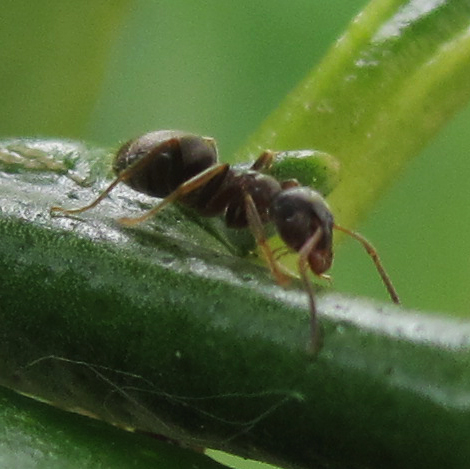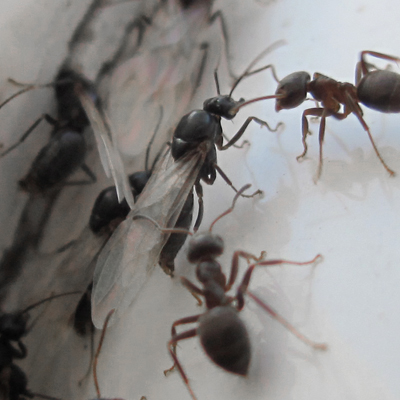Emmets: there’s a lot of them about and they are often considered a nuisance. I’m referring of course to ants.
 The Cornish-English dialect word for ant – emmet – is often used derisively to describe visitors who come to Cornwall at this time of year in particularly large numbers. It’s therefore no coincidence that Black Garden ants (Lasius niger) are also swarming from their nests in huge numbers, responding to the warm, humid summer weather. Their aim is to mate and start new colonies.
The Cornish-English dialect word for ant – emmet – is often used derisively to describe visitors who come to Cornwall at this time of year in particularly large numbers. It’s therefore no coincidence that Black Garden ants (Lasius niger) are also swarming from their nests in huge numbers, responding to the warm, humid summer weather. Their aim is to mate and start new colonies.
The Black Garden Ant is our most common species, out of some 50 ant species across the UK, several of which choose gardens in which to live. Ants are social insects, living strictly ordered lives within a colony. Over autumn, winter and spring, the colony comprises a single large queen (up to 15mm long) and hoards of smaller, sterile and flightless female workers, which have developed from eggs laid by the queen. As summer approaches, she lays eggs that develop into fertile winged males and females. These fertile adults perform the mating swarms on warm, sunny days after which the females establish new colonies. Each successful new queen may then live for as long as 15 years.
 The flightless workers in a colony measure around 5mm in length. They can be seen going about their frenetic activity, following and laying scent trails designed to direct colony members along established routes to food and other important resources. The omnivorous ant diet is surprisingly varied. Ants will take live prey if it can be overcome – such as other small insects and their larvae – as well as the remains of dead creatures.
The flightless workers in a colony measure around 5mm in length. They can be seen going about their frenetic activity, following and laying scent trails designed to direct colony members along established routes to food and other important resources. The omnivorous ant diet is surprisingly varied. Ants will take live prey if it can be overcome – such as other small insects and their larvae – as well as the remains of dead creatures.
They gather nectar, seeds, and other plant material; their penchant for sweet things even extends to ‘farming’ aphids and other sap-sucking insects for the honeydew secreted by these creatures. Ants guard their ‘livestock’ attentively, seeing off attack from other predators and moving their ‘stock’ to fresh plant resources.
Ants like to nest in generally dry, sheltered places. They are often regarded as pests by gardeners, since they tend to construct their colonies in places we consider inconvenient, such as lawns, under paving blocks and around the bases of precious plants. Despite the mess sometimes caused by their excavations, ants are quite harmless to humans and they do not pose any disease threat. Perhaps we should be rather more tolerant of them and even appreciate these amazing creatures for their complex and fascinating ecology.
Cirl Bunting Reintroduction Project News
Our most recent milestone has been achieved! Last month, having recorded 45 breeding pairs, we set the next milestone to 50 and it was soon reached. To date, we now have 51 breeding pairs recorded, and the next milestone of 55 has now been set accordingly.
What to look out for this month in the Roseland
- There are still large numbers of Great, Sooty and Manx Shearwaters being observed offshore, as well as sightings of Storm petrel and Great Skua.
- If you’re out on the water you may be lucky enough to spot Humpback whale and Risso’s Dolphin, along with Common Dolphin and Harbour Porpoise. There is also the possibility of the odd basking shark passing through. St Anthony Head is a good place to view a wide sweep of Falmouth Bay and beyond, to look out for sea life.
Did you know…
That corvids like shellfish? If you take a stroll around many of our coastal fields, you are likely to come across the odd queen scallop or mussel shell lying in the grass, far inland from the sea where its occupant was living. The reason for this is that crows and ravens are foraging for shell fish at low tide, then bringing the shells into the fields where they are less likely to be hassled by other birds hoping to steal the prey item. To prize open a shell, a bird will fly up to an optimal height from where it drops the prize onto a hard surface. The impact helps to loosen the the two halves of the shell, permitting the bird access to the meal within.
References
The Royal Entomological Society (2015) Ants (Hymenoptera). Online article. Available from: http://www.royensoc.co.uk/insect_info/what/ants.htm
National Insect Week (2015) Online article. Available from: http://www.nationalinsectweek.co.uk/insect_info/what_insect/black_garden_ant.htm
Krebs, JR, Davies, NB (1993) An Introduction to Behavioural Ecology. Wiley-Blackwell, Chichester, UK.
All Photography by Sarah E Vandome, unless otherwise indicated.
Enjoy more Roseland wildlife and landscapes – visit my Heart of Roseland Facebook feature:

